1993 VOLKSWAGEN GOLF fuel consumption
[x] Cancel search: fuel consumptionPage 2 of 156

Downloaded from www.Manualslib.com manuals search engine l
,
l
You have chosen the European bestseller, the Golf
... and the environment
Built for the future
You I ave chosen a car Whlcli is ladlcal in ev ry respeCt. Even concerning the environ
ment Your new Golf has been developed to damage the e nvironme nt as little as possIL le Nor o nly today, but tomorrow and In he
'utu r .
Clean solutions from clean ideas
W e beheve that more can be done fo r the
envtronment today If we forgo some th ings.
S o
In manufacturing your new Golf , we have . wherever possib le, forgone environmentall y harmful materials, for e :amp le CFCs In p lastic parts, cadmium and asbes
t os .
For [he paintwork. we are fO I going chemica l
solvents to an ever rncreaslng degree, and sing more and more aler-based paints
Clean performance
Naturally, all engines fitted III the Golf are low pollutants .
They are particularly qUiet
and low In uel
consumption That is of course dependent on your driv ing style . Tips and advice on the
s ubject can be found in thiS manual Exactly
Ihere can b e found in the alpha betrcallnde x
under the heading" EnVIronm ent" .
Reduced emissions
Vaporrzation -from plastics in th e ve hicle in
teriol or from the fuel tank -Will hardly occlIr In you r new Golf.
For examp le, we have llserl new materlals
for the Instrument panel, and the walls of the fuel tank have be en treated to red uce emiSSions a" much as pOSSible
A sign of the times
Y our new Golf has been constructed In such
a wa y that It can be disp osed of env ironmen
t ally
The plast iC parts have
a speCial marking to Simplify Identlfeat lon and reprocessing of materials at a later date.
Some of these plastiC parts are made entire
l y from
recy cled mate rial.
These really a re signs of tile times.
... and more safety
Safe all round
Your nevy Golf has exemp lary safet y.
It offers an extraordinar y high deg ree of aci e and pass i e safet
Active -from the running
gear to the ergo
nomics of the interior . Passive -from the
fron enlj structure nd the passenge r cell , the steenng, the steerlllg wheel, the seats ,
through 10 he seat belt sYStem With bel tra e an oressure limiters for driver ilnd fro· seat passenger.
.411 15 S he result of our safety philosophy.
For us sa ety means protection .
~ '" e ar Iples
Safe and Sound
All mo,
By,
ev e
wh
str i
Sa
E VE fe e
T he
a nc
f
ro' eVE
I t (
T h , Slt
m" d ar
in c
Cu
T h
o p·
b e p re
i m
Page 34 of 156
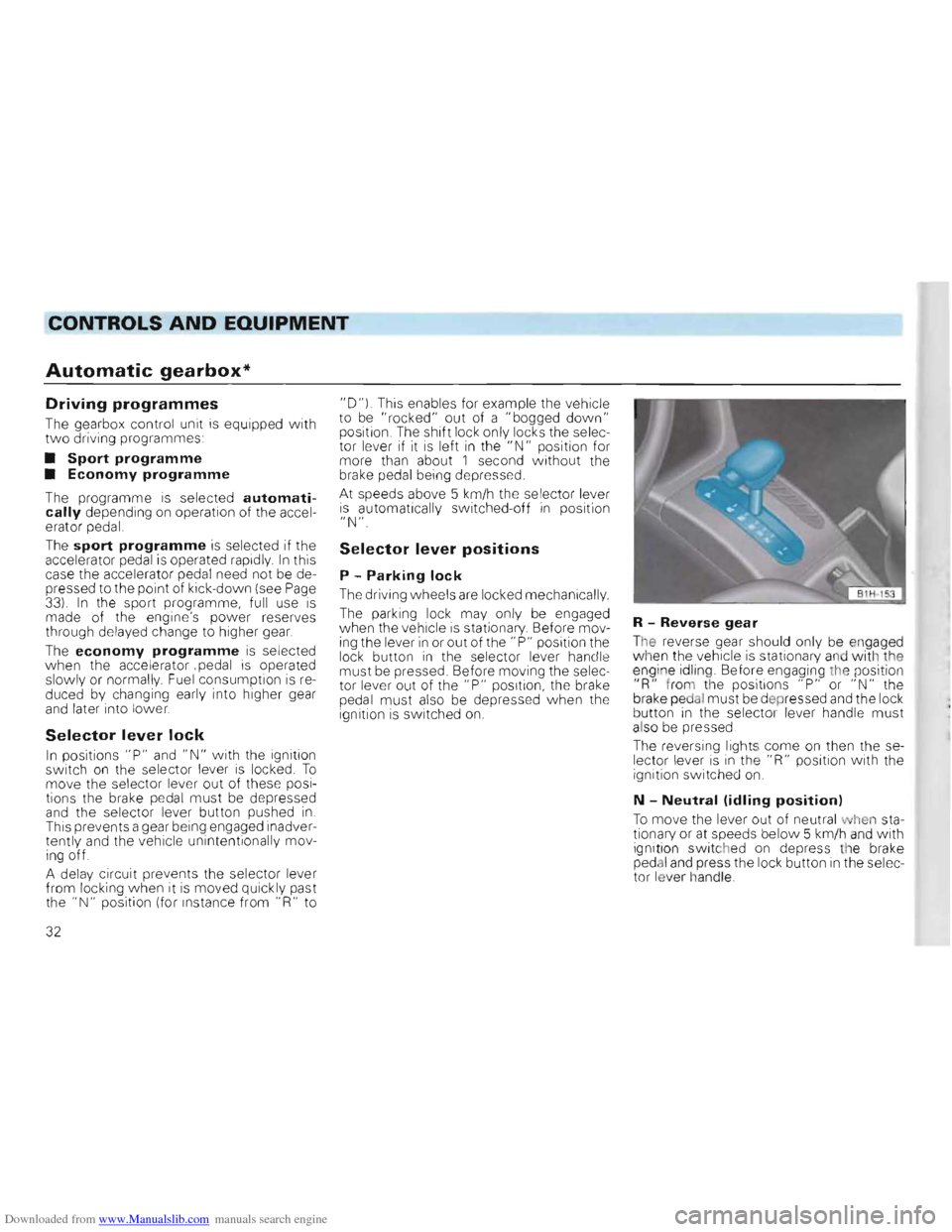
Downloaded from www.Manualslib.com manuals search engine Automatic gearbox*
Driving programmes
The gearbox control unit is equipped with two driving programmes:
• Sport programme
• Economy programme
The programme is selected automatically depending on operation of the accel
erator pedal.
The sport programme is selected if the
accelerator pedal is operated rapidly. In this
case the accelerator pedal need not be de
pressed to the point of kick-down (see
Page 33). In the sport programme, full use is made of the engine's power reserves
through delayed change to higher gear
The
economy programme is selected
when the acce lerator, pedal is operated
s lowly or normally. Fuel consumption is reduced by changing early into higher gear and later into lower.
Selector lever lock
In positions "P" and " N" with the ignition
s wi tc h on the selector lever is locked . To move the selector lever out of these posi
t ions the brake pedal must be depressed and the selector lever button pushed in .
This prevents a gear being engaged inadver
tently
and the vehicle unintentional ly mov
ing off .
A de l
ay circuit prevents the selector lever
f rom locking when it is moved quickly past the" N" position (for Instan ce from" R" to "
D " ) This enables for examp
le the vehicle
to be " rocked" out of a "bogged down "
position The shift lock only locks the selec
tor
leve r if it is left in the " N" position for
more than about 1 second without the
brake pedal being depressed.
At speeds above 5 km/h the selector lever
is automatically switched-off in position "N".
Selector lever positions
P -Parking lock
The driving wheels are lock ed mechanically
The parking lock may only be engaged
when the vehicle is stationary. Before mov
ing the lever in or out of the" P" position the
lock button in the selector lever handle
must be pressed. Before moving the selec
tor lever out of
the" P" pOSition, the brake
pedal must also be depressed w hen the
ignition is switched on .
R -Reverse gear
The reverse gear should only be engaged
when the vehicle is station ary and with the
eng ine id ling. Before engaging the position
"R " from the positions "P" or "N " the
brake pedal must be d epr essed and the lock
b u tton in the selecto r lever handle must
also be p re ssed .
The
reversing lights come on then the se
l e cto r leve r is in the "R" position with the
ignition switched on.
N -Neutral (idling position)
To move the leve r out of neutral when sta
tionary or at speeds below 5 km/h and with
ignit ion switc hed on depress the brake
ped al and press the lock button in the selec
t or lever handle .
32
Page 44 of 156
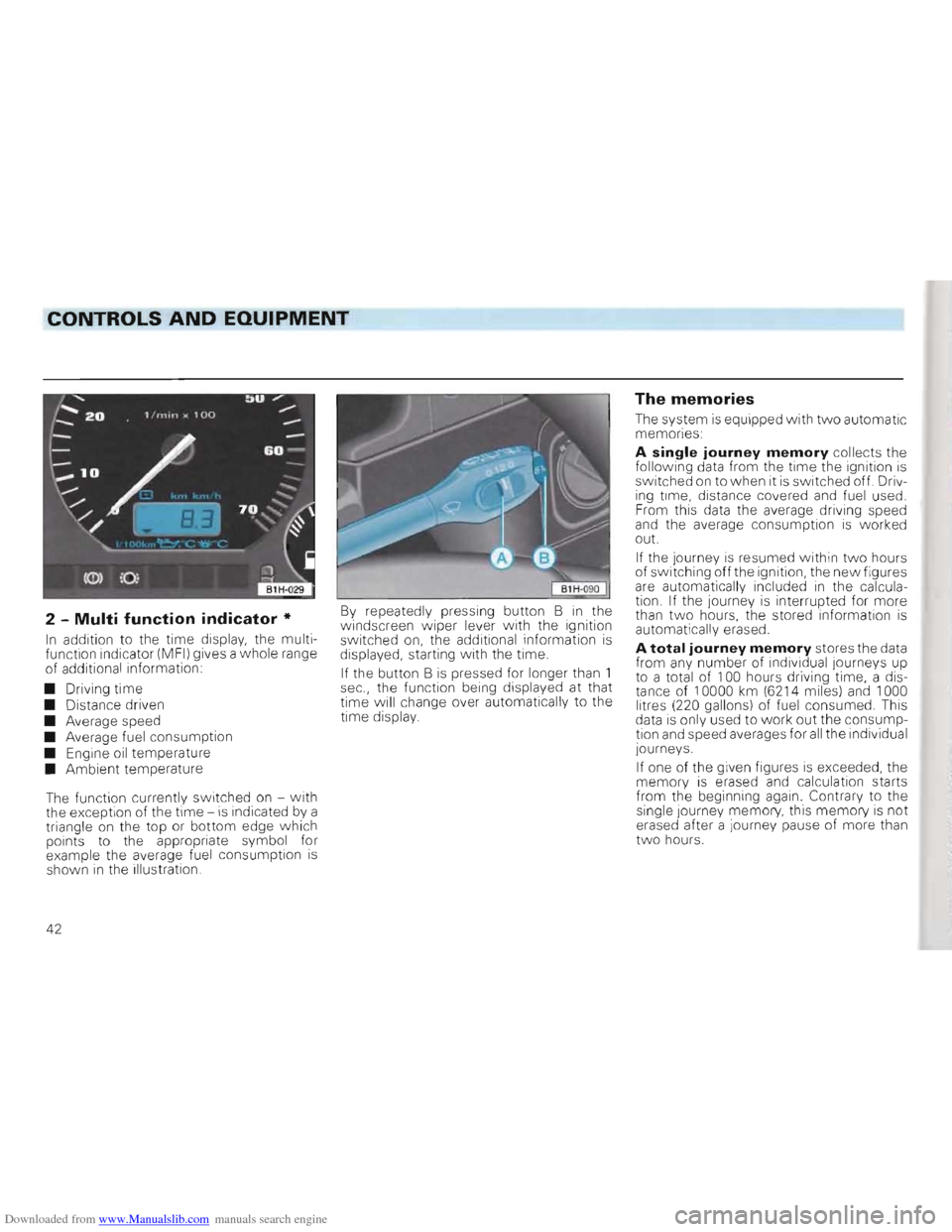
Downloaded from www.Manualslib.com manuals search engine CONTROLS AND EQUIPMENT
2 -Multi function indicator *
In addition to the time display, the multi
function indicator (MFI) gives a whole range
of additional information:
• Driving time
• Distance driven
• Average speed
• Average fuel consumption
• Engine oil temperature
•
Ambient temperature
The function currently switched on -
with the exception of the time -is indicated by a
triangle on the top or bottom edge which
points to the appropriate symbol for
example the average fuel consumption
is shown in the illustration.
By repeatedly pressing button B in the
windscreen wiper lever with the ignition
switched on, the additional information is displayed, starting with the time.
If the button B
is pressed for longer than 1
sec., the function being displayed at that
time will change over automatically to the
time display.
The memories
The system is equipped with two automatic
memories:
A single journey memory collects the
following data from the time the ignition is
switched on to when it is switched off. Driv
ing time, distance covered and fuel used.
From this data the average driving speed
and the average consumption
is worked
out.
If the journey is resumed within two hours
of switching off the ignition, the new figures
are automatically included in the calcula
tion. If the journey is interrupted for more
than two hours, the stored information is
automatically erased.
A total journey memory stores the data
from any number of individual Journeys up
to a total of 100 hours driving time, a dis
tance of 10000 km (6214 miles)
and 1000
litres (220 gallons) of fuel consumed. This
data
is only used to work out the consump
tion and speed averages for all the individual
journeys.
If one of the given figures
is exceeded, the
memory is erased and calculation starts
from the beginning again. Contrary to the
single Journey memory, this
memory is not
erased after a journey pause of more than
two hours.
42
Page 45 of 156
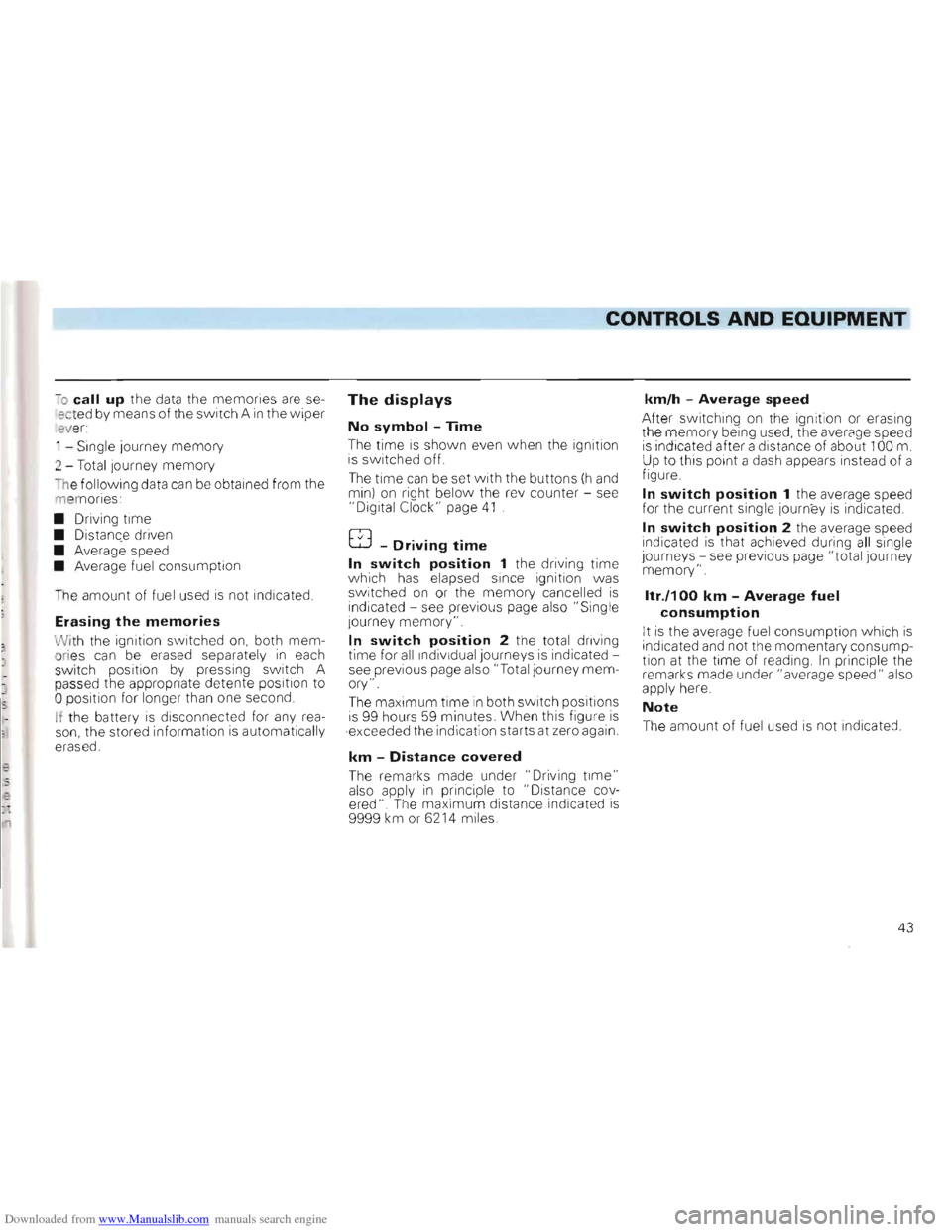
Downloaded from www.Manualslib.com manuals search engine CONTROLS AND EQUIPMENT
-0 call up the da ta th e memories are se
ac ted by means of the switch A in the wiper
ev er:
. - S
ingle jou rne y memory
2 -
Total jo urne y memory
l1e foll owi ng data can be ob tained from the
m em ories :
•
Driving time
• Distance drive n
• Average speed
• Averag e fuel cons umpti
on
he amount of fuel used IS not indicated.
Erasing the memories
With the ignition switched on, both mem
ories can be eras ed separate ly in eac h switch positio n by pres sing sw itch A
p assed the appro priate detente position to opositio n for longer than one second.
If t
he battery is discon nected for any reason, the stored information is automaticall y
erased .
The displays
No symbol -Time
The time is shown even when the ignitio n
i s switched off.
The time can be set with the butt ons (h and min) on right below the rev count er -see
"Dig ita l Clock" page 41
G -Driving time
In switch position 1 the driving time
which has elapsed since ig nition was
switc hed on or the memory cance lled is indica ted -see previous page also "Single
j o urney memo ry"
In switch position 2 the total driv ing time for all IndiVidual jo urneys is ind icatedsee previous page also " T otal journey mem
ory"
The maximum time in both sw itch positions is 99 hours 59 minutes. When thi s figure is exceeded the indicatio n starts at zero again.
km -Distance covered
The remarks made under "Dri ving time" also aoply in principle to "Dist ance cov
ered" 'T he maxim um distance indicated is
9999 km or 6214 miles.
km/h -Average speed
Afte r swi tching on the ignitio n or eras ing
the memory being used, the average speed is in d ic ated after a dista nce of about 100 m . Up to th is point a dash appea rs instead of a
figure.
In switch position 1 the ave rage speed
for the current single journe y is ind icated.
In switch position 2 the average speed
indicated is tha t achieved during all single
j ourneys -see prev ious page "total jou rne y
memory"
Itr./100 km -Average fuel
consumption
It is the ave rage fuel cons umption which is in dicated and not the momentary consump
t ion at the time of reading. In principle the
remarks made under "average speed" also
apply here.
Note
The amount of fuel used is not indicated.
43
Page 54 of 156
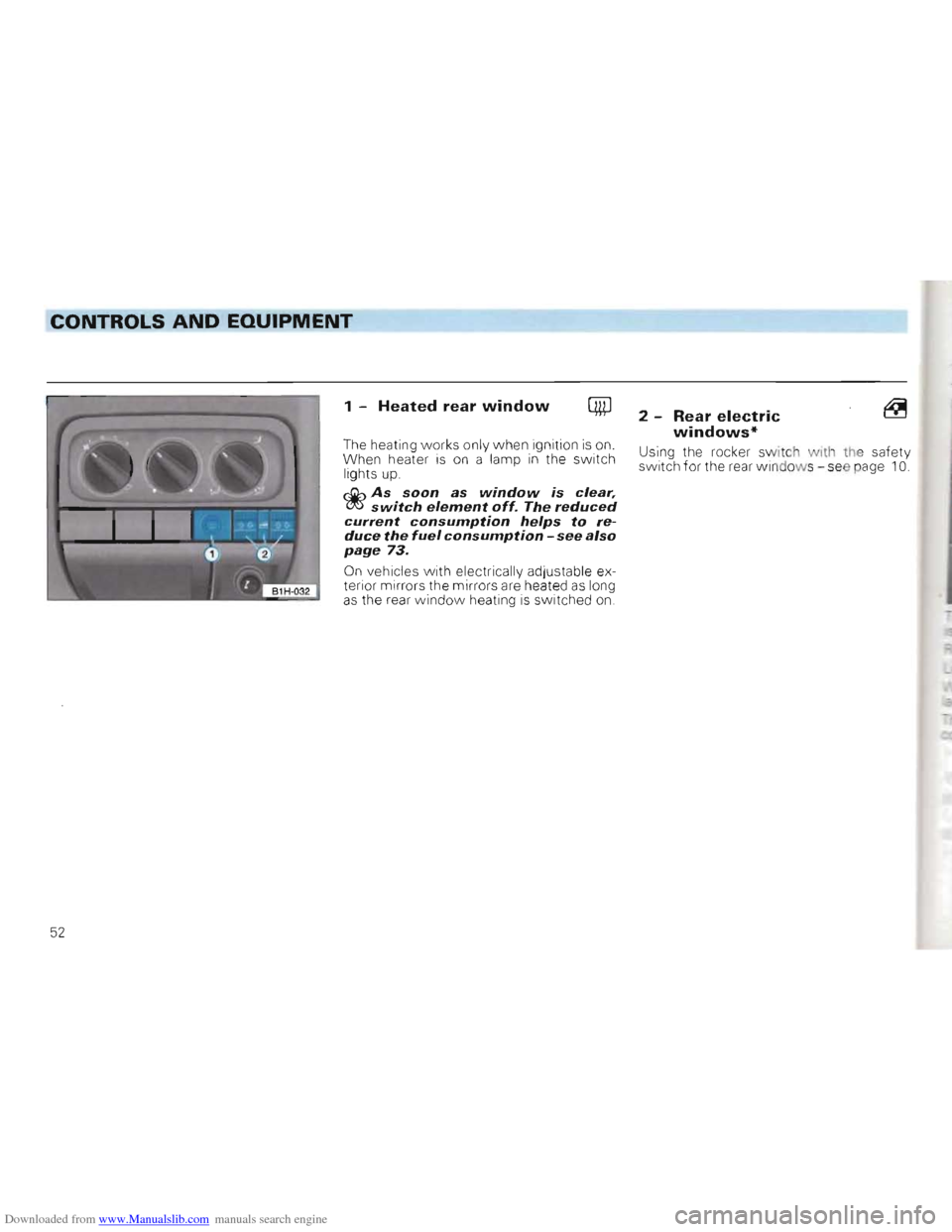
Downloaded from www.Manualslib.com manuals search engine CONTROLS AND EQUIPMENT
1 -Heated rear window
The heatin g works only when ign it io n i s on.
W hen heate r i s on a lamp in the switch ligh ts up.
~As soon as window is clear, ~switch element off. The reduced current consumption helps to reduce the fuel consumption -see also page 73.
On veh ic les with electrically adjustable ex
terio r m irrors the mirrors are heated as long as the rear w indow heating is switched on.
2 -Rear electric windows·
Using the rocker switch with the safety
switch for th e rear window s -see page 10.
52
Page 66 of 156

Downloaded from www.Manualslib.com manuals search engine CONTROLS AND EQUIPMENT
Operating instructions
• Ensure that the sensor betvveen the
windscreen defrost outlets in the centre of
the instrument panel and the air grille next
to the radio is not covered.
• If, after switching on the ignition,
all sym
bols in the display area flash for about 15
seconds, there is a fault in the system -con
tact a Volkswagen dealer.
Notes for both air conditioning
systems
• To ensure that the heating, ventilation
and air conditioner can work properly, the air
inlet in front of the windscreen should be
kept free of ice, snow and leaves.
• The heat output depends
on the coolant
temperature -the full heat output is there
fore available when the engine IS warm.
• The stale air escapes through openings
in the luggage compartment side panels.
Therefore when loading the luggage com
partment ensure that the openings are not
covered .
• When the ambient temperature
is high
and the air very humid, condensed water can drip off the evaporator and form a
puddle under the vehicle. This is quite nor
mal and does not indicate a leak.
Notes for the normal air condi
tioner
• All controls except the rotar y switch A and buttons 0 and E can be set to any inter
mediate position.
•
To prevent the windows from misting up
the blower should be running slowly when driving at low speeds.
Using air conditioners economi
cally
In cooling operation the air conditioner com
pressor places demands on the engine and
therefo re influences the fuel consumption.
To keep the period switched on as short as possible, the following points should be
noted:
• If the
in side temperature is very high
after the car has been parked in the sun, it is recommended to open doors or windows briefly to enable the hot air to escape
• The air conditioner should not be
switched on during a Journey if the
windows or sliding/tilting roof* are open.
• If the desired interior temperature
can be attained w ithout switching on the air
cond itioner the fresh air operation should
be selected (does not apply to Climatronicl.
Operating faults
• Should the air cond i:ioner not work at
any time, either .
- the ambient temperatu re IS below about +5 °C,
-or the fuse has blown.
Check fuse and if necessary r
enew it - see
page 119. If the troub le is n ot due to a defec
tive fuse, SWitch the system off and have It
checked.
- the air conditioner
has svvitched off due
to coolant temperature being too high -see
page 45.
• If the cooling output drops off, switch
the AlC
off and have the system checked.
64
Page 74 of 156
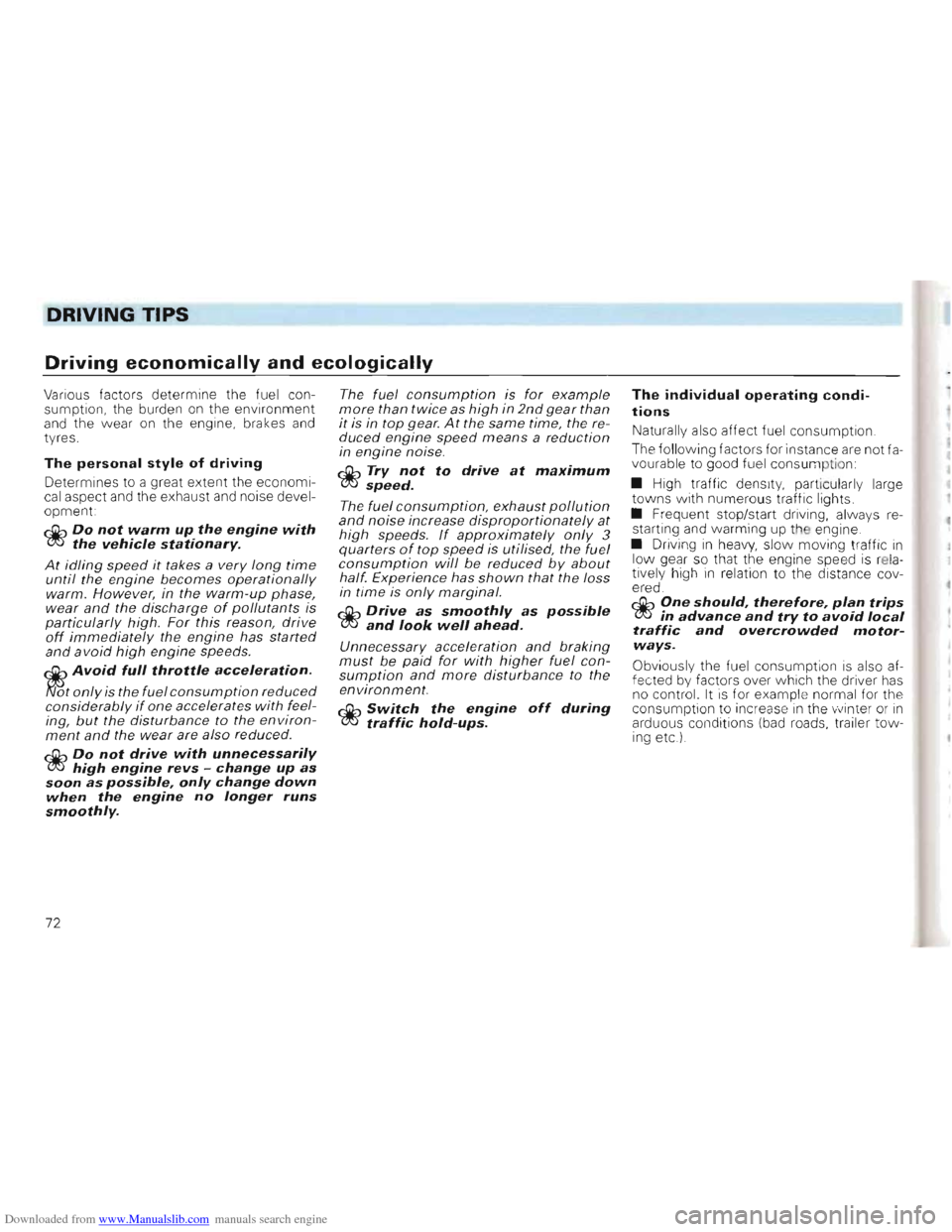
Downloaded from www.Manualslib.com manuals search engine DRIVING TIPS
Driving economically and ecologically
Various factors de te rmi ne the fuel c on
sumption, the bur de n on the environment
a n d the w ear on the engi ne, brake s an d
t y res .
The personal style of driving
Determine s to a g reat extent th e eco nomical asp ect and the e xha u st an d no ise deve lo pmen t:
r:Q,., Do not warm up the engine with '(!t!5 the vehicle stationary.
At idling speed it takes a very long time until the engine becomes operationally warm. However, in the warm-up phase, wear and the discharge of pollutants is particularly high. For this reason, drive off immediately the engine has started and avoid high engine speeds.
QiP Avoid full throttle acceleration.
N'6t only is the fuel consumption reduced considerably if one accelerates with feel
ing, but the disturbance to the environment and the wear are also reduced.
r:Q,., Do not drive with unnecessarily '(!t!5 high engine revs -change up as soon as possible, only change down when the engine no longer runs smoothly.
The fuel consumption is for example more than twice as high in 2nd gear than it is in top gear. At the same time, the reduced engine speed means a reduction in engine noise.
r:Q,., Try not to drive at m aximum '(!t!5 speed.
The fuel consumption, exhaust pollution and noise increase disproportionately at high speeds. If approximately only 3 quarters of top speed is utilised, the fuel consumption will be reduced by about half. Experience has shown that the loss
in time is only marginal.
r:Q,., Drive as smoothly as possible '(!t!5 and look well ahead.
Unnecessary acc eleration and braking must be paid for with higher fuel consumption and more disturbance to the environment.
r:Q,., Switch the engine off during '(!t!5 traffic hold-Ups.
The individual operating condi
tions
N atur ally also affect fuel cons umption .
T he fo
llowing facto rs fo r in sta n ce are not fa
vo urable to good fuel c on sumption:
• Hig h traff ic de ns it y , par ticularly larg e
t o w ns w ith numero us traffi c lig ht s
• Freq ue nt sto p/s tart d
riving, alw ay s re
s ta rti ng a nd warmin g up t he eng ine
• D riving
in heavy , slow moving traff ic in
l o w gear so that the eng ine sp eed is rela
ti vel y high in relati on to the distan ce cov
e red.
r:Q,., One should, therefore, p la n trips
'(!t!5 in advance and try to a void l ocal
traffic and overcrowded motor
ways.
O bvio usly the fuel consumption is also af
fec ted by facto rs o ve r w hich the drive r has
n o control. It is for exampl e no rma l for th e con sumpti o n t o increase in th e ,,\linte r or in arduous cond iti ons ( bad roads, trailer towing etc)
72
Page 75 of 156
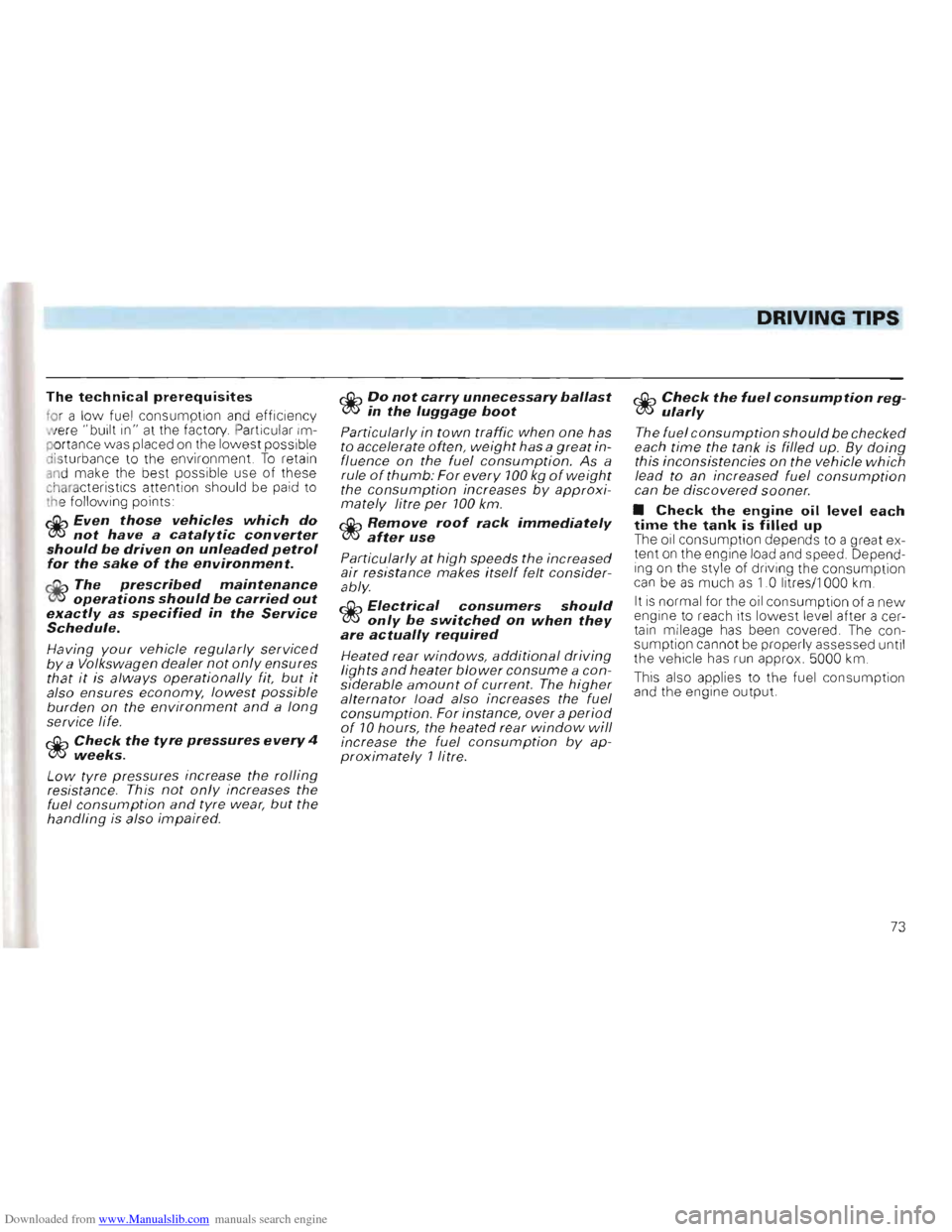
Downloaded from www.Manualslib.com manuals search engine DRIVING TIPS
The technical prerequisites
for a low fuel consumpt ion and efficienc y "" ere " built in" at the factory. Particular Im
p ortance was placed on the lowes t possible
d is turban ce to the enviro nme nt. To retain and make the best possible use of these characteristics attent ion should be paid to the fo llow ing points
~Even those vehicles which do W not have a catalytic converter should be driven on unleaded petrol for the sake of the environment.
~The prescribed maintenance W operations should be carried out exactly as specified in the Service Schedule.
Having your vehicle regularly serviced by a Volkswagen dealer not only ensures that it is always operationally fit, but it also ensures economy, lowest possible burden on the environment and a long service life.
~Check the tyre pressures every 4 W weeks.
Low tyre pressures increase the rolling resistance. This not only increases the fuel consumption and tyre wear, but the handling is also impaired.
~Do not carry unnecessary ballast W in the luggage boot
Particularly in town traffic when one has to accelerate often, weight has a great influence on the fuel consumption. As a
rule ofthumb: For every 100 kg ofweight the consumption increases by approximately litre per 100 km.
~Remove roof rack immediately Wafter use
Particularly at high speeds the increased air resistance makes itself felt considerably.
~Electrical consumers should W only be switched on when they are actually required
Heated rear windows, additional driving lights and heater blower consume a considerable amount of current. The higher alternator load also increases the fuel consumption. For instance, overa period of 10 hours, the heated rear window will increase the fuel consumption by approximately 1 litre.
~Check the fuel consumption regW ularly
The fuel consumption should be checked each time the tank is filled up. By doing this inconsistencies on the vehicle which lead to an increased fuel consumption can be discovered sooner.
• Check the engine oil level each time the tank is filled up The oil consumption depends to a g reat ex
tent on the engine load and speed. Depend
ing on the style of driving the consumption
can be as much as 1 .0 litr es/1 000 km .
It
IS no rmal fo r the oil consumption of a ne w
engine to reach its lowest level after a cer
tain mileage has be en covered . The con
sumption cannot be properly assessed until
the vehicle has run appro x. 5000 km.
This also applies to the fuel consumption
and the engine output.
73